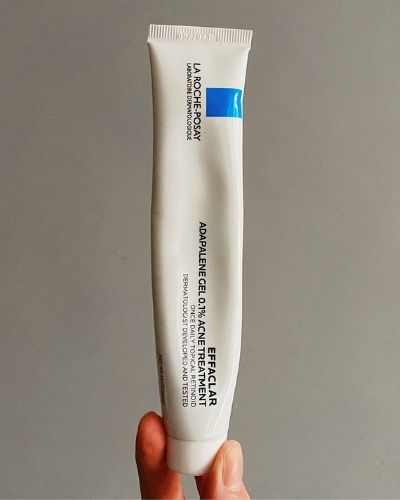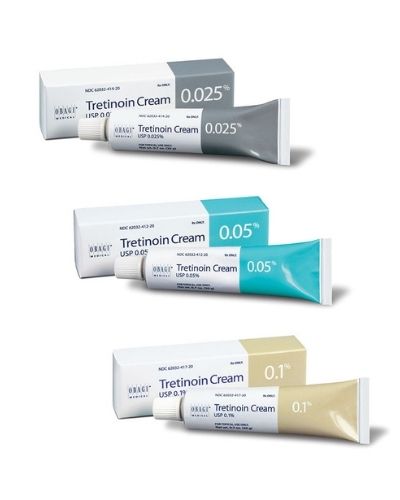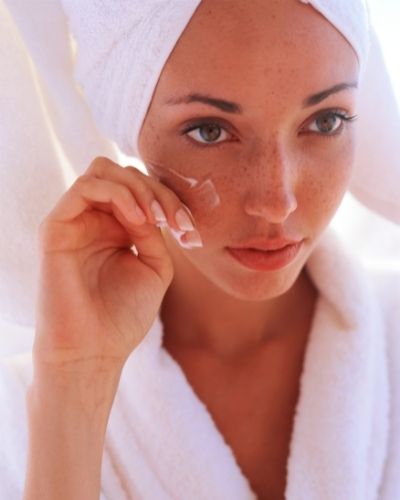People with acne often wonder if they should be using anti-aging products in addition to their acne treatments. So, which is better: Adapalene or Tretinoin?
In this article, I will compare the two and help you decide which one is best for you.

What are Adapalene and Tretinoin, and What do They do?
Adapalene (also known under the brand name Differin and La Roche Posay) and tretinoin (also known as retinoic acid) are both retinoids that fight acne, but tretinoin also targets signs of skin aging.
Both ingredients speed up cellular turnover and cause the skin cells to shed faster, revealing a smoother, brighter, clearer, and more uniform complexion with continuous use.
How are Adapalene and Tretinoin Different From Each Other?

The primary difference between adapalene and tretinoin is that adapalene has mainly been studied for treating acne, while tretinoin has also been proved through multiple studies to improve signs of skin aging such as fine lines, wrinkles, and hyperpigmentation.
Therefore, tretinoin is definitely a better anti-aging option.
What are the Benefits of Using Adapalene Over Tretinoin, or Vice Versa?
Tretinoin was discovered first and has been used as an acne treatment since 1971. While being recognized as an efficient acne treatment at first, it was later discovered that tretinoin has many other benefits, such as targeting signs of aging, pigmentary issues, etc.
Adapalene came onto the scene much later and was approved for use in the treatment of acne in 1996.
But besides the 25 years difference between the two, there are also some minor differences in their effect on the skin.
Adapalene is far less irritating than tretinoin, and even though clinical studies have proved that adapalene is as efficient as 0.25% tretinoin, this active ingredient is generally better tolerated by all skin types.
On the other hand, tretinoin can be pretty aggressive on the skin, and sensitive skin types are likely to need longer to get used to the active ingredient and are likely to experience more side effects while getting used to its effects.
However, the most significant difference between the two is that adapalene is primarily suggested as a treatment for people dealing with acne, while tretinoin is an efficient treatment for both acne and common skin aging and discoloration concerns.
Lastly, adapalene has a unique physiochemical profile that allows it to be stable enough to be used as a part of a morning routine.
On the other hand, tretinoin is unstable in UV presence, which is why it’s strictly recommended to be used in an evening routine.
How to Choose the Right Product for You?

Choosing between adapalene and tretinoin is very easy, simply because whatever option you choose will give results.
But namely, if your skin is sensitive and you are dealing with acne, you can go with adapalene.
If your skin is more resilient and you want to target some other skin concerns, such as signs of aging and pigmentary issues, you should go for tretinoin.
You should also consider the laws of your country because adapalene is sold over the counter in the US while it requires a prescription in Europe.
On the other hand, tretinoin is easier to get in Europe because an appointment at the dermatologist is more affordable and easier to arrange, while dermatologist offices can sometimes make you wait for months to get an appointment in the US.
RELATED: Beginners Guide to Tretinoin.
Can You Use Adapalene and Tretinoin Together?
Using adapalene and tretinoin together isn’t necessary because they give very similar results with the addition of the anti-aging boost tretinoin provides.
If skin aging is also your concern alongside acne, you can opt for tretinoin, which will get the job done.
Using adapalene and tretinoin together is not only unnecessary but is likely going to dry out and irritate your skin and even push it into rosacea territory.
What are the Side Effects of Both Adapalene and Tretinoin?

Although adapalene and tretinoin are both very efficient in improving many skin concerns, including acne, skin texture, hyperpigmentation, wrinkles, and other signs of aging, they definitely come with their own set of troubles, which is why it’s advisable to take it easy and give your skin extra care when starting with either option.
Here are the most common side effects of using adapalene and tretinoin:
Dryness & irritation
Both adapalene and tretinoin work by speeding up the skin cell turnover cycle, ridding of the old layer of skin faster than usual.
This causes your skin to become dry and flakey as your skin purges and peels to become accustomed to the retinoid.
RELATED: How to Fix Dry Skin From Tretinoin?
Peeling
Peeling and shedding is another common side effect caused by the increased skin cell turnover cycle.
The skin usually peels the most around the mouth, but this unwanted occurrence can develop in any areas where tretinoin is used.
It’s also very important to thoroughly wash tretinoin off your fingers and hands after applying it, as it will also cause these areas to peel, too.
On the other hand, adapalene doesn’t seem to have this effect, and although your fingers or hands are likely to be dry after applying it, peeling doesn’t usually occur.
In any case, it’s best to wash them off with soap.
Increased sun sensitivity
As your skin adapts to adapalene and/or tretinoin, it will likely become more sensitive to the sun.
This happens because the rapid cell shedding will somewhat incapacitate the skin to protect itself from the sun, which is why you will start experiencing sunburns much quicker than it took you to experience them before starting tretinoin.
This is why wearing sunscreen is absolutely crucial while using either one of these retinoids because the sun damage on the skin has the potential to be even more severe while the skin is vulnerable due to their action.
So if you are experiencing a sudden warmth on your face, even if it’s not that hot outside, it’s a sign that your retinoid is working and that you need to apply sunscreen ASAP.
RELATED: Best Sunscreens To Use While On Accutane.
Purging
Both adapalene and tretinoin work by speeding up cellular turnover. This action will push all those dead skin cells that didn’t shed properly and remained inside the pore, mixing with skin oil and causing clogs to the surface of the skin.
So what will happen when you start using either one of these retinoids is your skin will basically purge all those clogs to the surface and turn them into pimples so that they can heal and disappear.
And because all of them will come out on the surface at the same time, instead of popping up as one or two pimples every few days or weeks, it will definitely look scary, but it is actually a good thing.
Lastly, while a purge usually lasts anywhere from 8-12 weeks, it’s not uncommon for it to stick around even up to six months or a year, especially if you are using skincare or makeup products that are continuing to clog your pores, because this way your retinoid will just continue to purge the clogs.
Comparison Chart
Here are some pros and cons of adapalene:
Adapalene Pros:
- Affordable.
- Can be bought over the counter in the US.
- Suitable for sensitive skin.
- Doesn’t cause excessive peeling.
- Works better for acne.
- Shorter purge period (usually around three months.)
- Can be used in a morning skincare routine.
- Helps reduce skin texture and post-inflammatory erythema.
- Suitable for rosacea-prone skin.
- Can be used during pregnancy.
Adapalene Cons:
- Sold only by prescription in Europe.
- Isn’t likely to help improve deeper lines and wrinkles.
And here are some pros and cons of tretinoin:
Tretinoin Pros:
- Improves acne, post-inflammatory hyperpigmentation, and post-inflammatory erythema.
- Improves uneven skin texture.
- Improves prominent signs of aging, such as deeper lines and wrinkles.
- Easily available in Europe.
Tretinoin Cons:
- Can be extremely irritating.
- Isn’t the best option for very sensitive skin.
- Not suitable for rosacea-prone skin.
- Can’t be used during pregnancy.

My name is Simone and I am a certified skin specialist. I created this website to teach my readers how to take great care of their skin and I also like to occasionally share my honest opinions on skincare products I’ve tried. You can learn more about me here.
